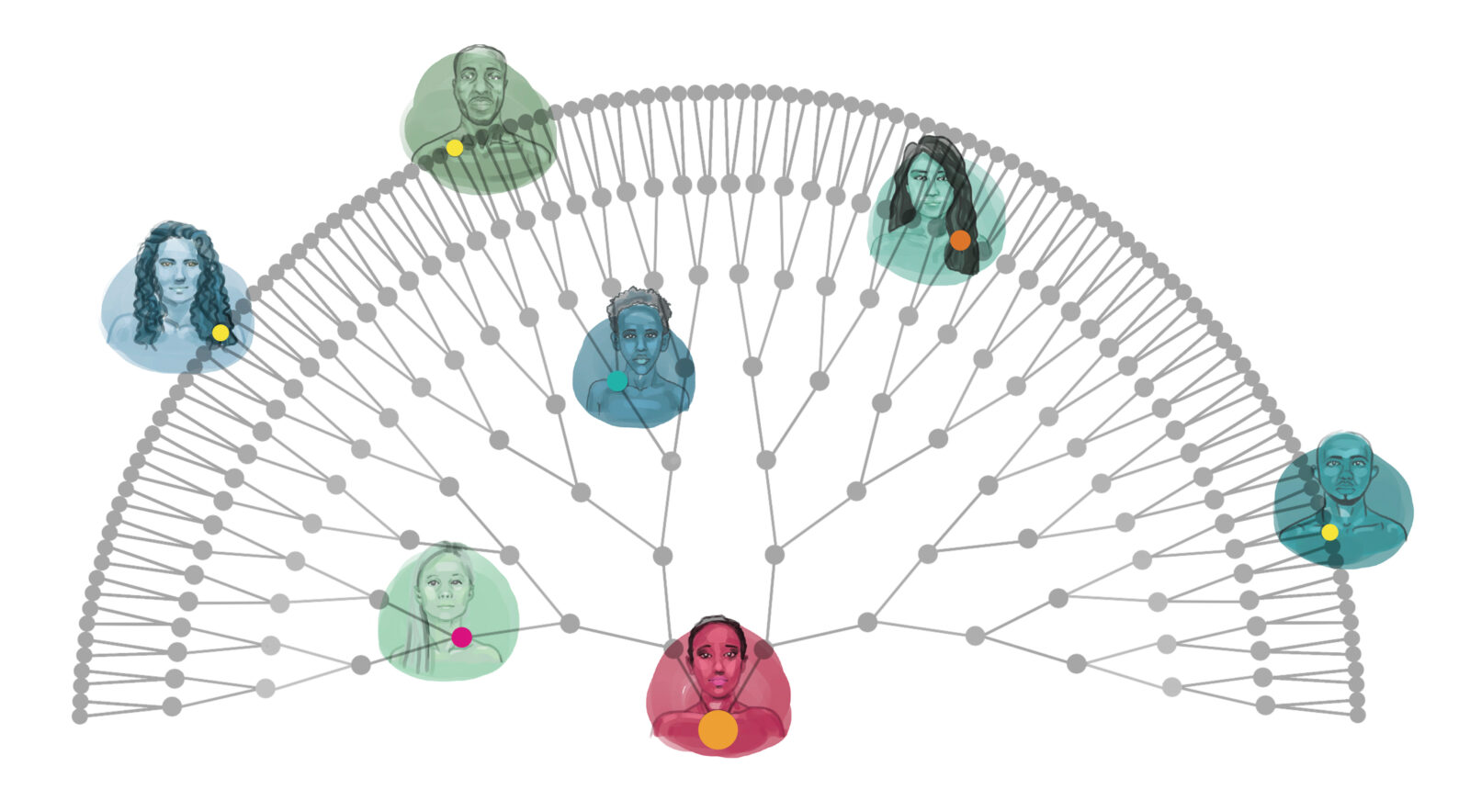
Diagram from The Centre for Systemic Constellations UK / Harper D’Amecourt.

Diagram from The Centre for Systemic Constellations UK / Harper D’Amecourt.
The aftermath of intergenerational trauma often sits silently and invisibly in the crevices of a family, presenting itself as recurring patterns of inappropriate or impulsive actions or feelings, chronic and potentially fatal illnesses or injuries, and an inability to reach contentment and fulfillment, even among those who are chronologically far removed from the initial traumatic events.
Family or systemic constellations is a method that attempts to uncover hidden relational dynamics within a family history with the intent of addressing the triggers and rebalancing the family system. Often the issues stem from events that have been too traumatic for the family system to carry: war and genocide, forced migration, sudden deaths, abortion and miscarriage, adoption, suicide, unresolved relationships, the rejection or banishment of a family member who committed a crime or is mentally ill. The afflicted generation might use exclusion and disconnection from this history as a means of coping, but these missing parts of the story can then reverberate down the generations and emerge intact in the life of a later member as unexplained, persistent mysteries.
Exclusion brings fragmentation to the self and the system it belongs to, and it requires an overwhelming expenditure of energy to maintain this psychic oblivion. When the invisible aspects are revealed and the trauma is integrated into the wider systemic story, its grip on the family eases and trapped life energy is freed.
Bert Hellinger (1925–2019), the founder of systemic constellations, was a German Catholic priest who worked for several years as a missionary with the Zulus of South Africa, where his interest in group dynamics grew. In the 1960s he participated in a series of interracial and ecumenical trainings that acquainted him with the power of phenomenology—a way of sensing and allowing our perceptions to surface in a clear, deep, present manner, circumventing our own interpretations.
These experiences planted the seed for his subsequent departure from the Catholic church, and phenomenology became the bedrock of family constellation work. Hellinger developed this method in the early 1980s after returning to Germany and training in psychoanalysis, Gestalt therapy, hypnotherapy, and more.
For Hellinger a phenomenological orientation could shed direct light onto what has been hidden from collective ideologies and family rules of belonging. He became fascinated by its ability to cut through and uncover untold truths, remaining objective and available to what wants to be seen and acknowledged, while weeding away preconceptions, judgments, diversity, fear, and anger. In postwar Germany, descendants of Nazi perpetrators and Jewish survivors needed a method that could transcend tragedy and make space for allowing respectful reconciliation. Family constellations proposed such a means by enabling people to face fateful truths in reverence and in service to future life.
A person who comes to explore an issue is the portal to their family system. They are usually seeking relief for recurrent patterns that have no apparent roots. The goal of a constellation session is to reveal what is hidden and give it its rightful place in the family system. From there, all can flow effortlessly, and the individual can begin to live a life free of ancestral burden waiting to be resolved.
Hellinger observed how a family system—which he often referred to as family soul—is like a mobile, and in order to maintain its balance, every member must belong, occupy their rightful place and engage in the ebb and flow of fair and equal give and take. When a family member from a previous generation has been banished from the family’s conscious awareness, a relative from a subsequent generation may have the impulse to fill the gap and unconsciously carry their fate. These people may not feel or act quite like themselves. Once this unconscious entanglement with someone in their system is brought to light, they can find a resolution and move toward liberation.
In a group session, the facilitator will ask the seeker to choose one of the participants to “represent” themselves and select others to stand in for certain members of their family. The seeker then places these people in the space. When the representatives, who are not known to the issue holder, tune in to their body sensations and intuition, they usually get in touch with and report with eerie accuracy feelings and information that belong to those they represent, regardless of whether those people are still alive. The representative needs only to observe and report their own sensations free of their interpretations.
Here is an example: A man seeking help for chronic pain in his right leg attended a session. The facilitator asked him to choose people from the group to represent members of his family going back three generations. The man complied but said he could not remember the name of his grandfather, because no one talked about him—he had left the family when the man’s father was very young. Nonetheless, the man asked someone to stand in for the unknown grandfather. The person who assumed the role said he had difficulty walking, and gradually he sensed acute pain in his right leg. The issue holder began to weep, recounting that he had heard once that the grandfather had left the family after an accident where he lost his right leg. No longer able to work to support them, he left out of shame, although it was perceived as abandonment and buried. The man had stepped into his grandfather’s place out of a pull to complete the family. The facilitator then suggested the man speak words of acknowledgement to the grandfather about what had taken place and ask for permission to return this fate back to the grandfather where it rightfully belongs, so the man could then live free of this predicament.
This concept of representation has triggered much skepticism, but scientists like Rupert Sheldrake have pointed to “morphic fields” as an explanation for how the past gets transmitted into the present. Morphic resonance involves the relaying of information and memories across time and space in a cumulative manner. Sheldrake and others believe that events are stored in nature, not in our brains, which instead act as transmitters and receivers.
Hellinger recognized that for a system to flow it must follow three natural laws, which he coined “orders of love.” First, everyone in a family system has an equal right to belong. Second, everyone occupies their right place in the hierarchy of the system, and the order of precedence is dictated by the time of belonging. Third, exchanges between family members or couples must maintain an equal give and take.
The orders are invisible to most but point to solutions that can restore one’s well-being. When the members of a system are aligned with the orders, they are guided by peace and strength, which allows love and intimacy to flow unobstructed and the original life force to spring from its source across and down the generations.

Lara Tambacopoulou is a peer counselor from the University of British Columbia and a Systemic Constellations facilitator trained at the Centre for Systemic Constellations in the United Kingdom. She conducts group and individual sessions in person and online. Lara is also the host of Future Primitive podcasts, where she holds conversations with modern thinkers, visionaries, and innovators. She lives between London and Athens and can be reached at [email protected].
Get the latest news and stories from the Rubin, plus occasional information on how to support our work.